Moroccan cuisine is known worldwide for its innovative and complex nature, creating dishes that blend sweet and savory elements together with the distinctive use of Moroccan spices, resulting in a complex yet harmonious and complementary flavor profile.
One of the secrets of Moroccan cuisine lies in its extensive repertoire of richly flavored Moroccan spices and herbs that enhance every dish without overpowering each other
In this article, we explore the array of Moroccan spices, providing a comprehensive guide for those who long to rediscover their once-tasted Moroccan wonders or simply want to spice up their cooking with these exquisite Moroccan spices!
Some links below may be affiliate links. As an Amazon Associate I earn from qualifying purchases.

Overview of Moroccan Spices and their uses:
Cumin
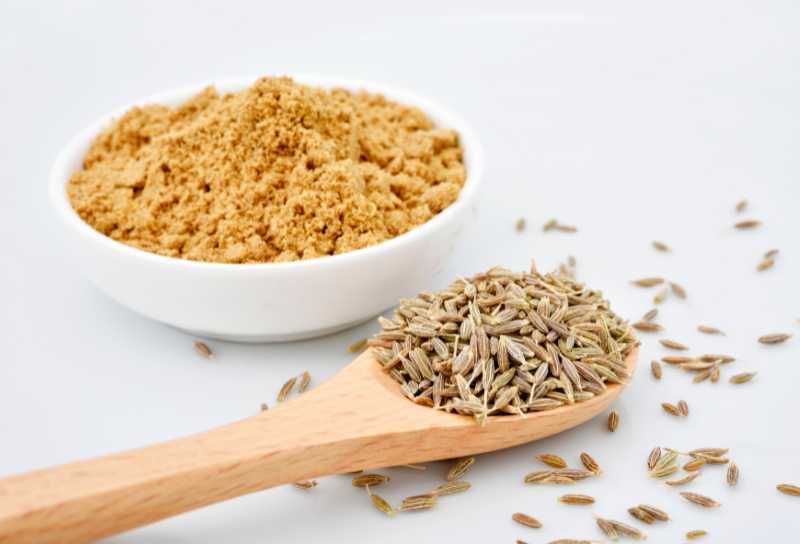
Although India is the largest producer and consumer of Cumin in the world, the oldest traces of this spice were found in 4000 years old Egyptian excavations.
Cumin is one of the most basic yet versatile spices in Moroccan cuisine. Thanks to its robust flavor profile, it can be used as a stand alone spice.
However, its warm earthy flavor can bring out or balance out other spices as well. For example, salt and cumin are like coffee and cream, better when combined.
They are usually mixed in a bowl ready to be sprinkled over anything and everything from boiled potato, fish, salad, soup, boiled or fried egg, etc.
Sweet paprika (Tehmira)
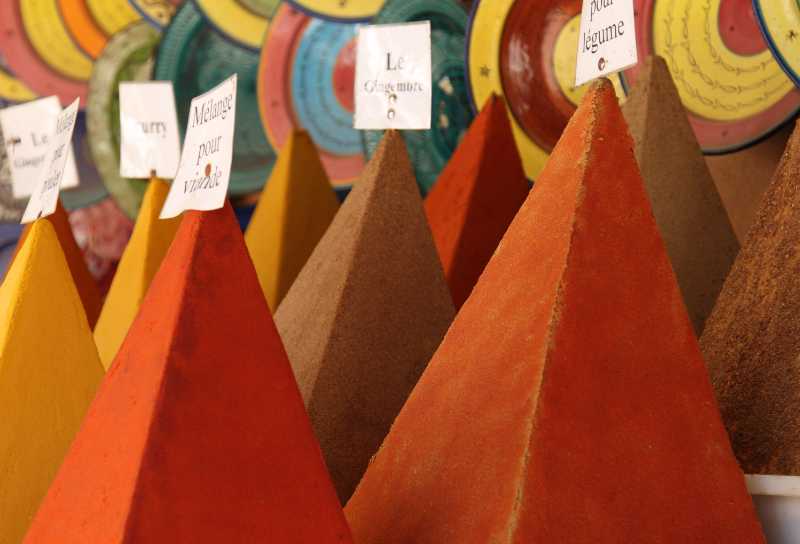
Sweet paprika is made from freshly ground, sun-dried sweet red peppers. It is highly valued in Moroccan cuisine for its vibrant red color and its fruity, mild, peppery, and slightly bitter taste, which adds a complex layer of flavor to any dish.
Sweet paprika is commonly used in dishes that require a red hue or have a tomato base.
It complements dishes such as bean, egg, and meatball tomato sauce tagine, as well as cooked salad dips like Taktouka (made with green bell peppers and tomatoes), Zaaluk (made with eggplant and tomatoes), and Shakshuka (made with garlic, harissa paste, ground cumin, chopped tomatoes, and eggs).
Cinnamon (karfa)
Cinnamon in both forms, ground and bark, is a characteristic of Moroccan cuisine. It is an unreplaceable spice in all Moroccan sweet-and-salty dishes like Pastilla, Sefa, and caramelized Tagine.

It is a key spice in sweet desserts such as pastries (ex: Mhancha and Jawhara or milk Pastilla); almond and peanut cookies; fruit salads; and Sellou (a rich, nutty confection of ground nuts and seeds).
It is also present in meat marinades and runs in combination with other seasonings as an accent and tenderizer substitute.
Black pepper (Ibzar)
Once called black gold by the Romans for its highly valuable nature and trade for gold, today,
black pepper takes the title of the king of spices due to its popularity across all cuisines. In Morocco, we find white, gray and black pepper.
In Morocco, black pepper is omnipresent in most recipes. Its strong, piney and citrusy flavor is guaranteed to give any dish a kick. Its balmy counterpart is used in sauces
Turmeric (querkoum)
Turmeric or Kharkoum Beldi is a Moroccan culinary staple. It is used in its ground form as a colorant as its warm hue stimulates appetite.
It is also popular for its distinct slightly bitter and earthy notes which go perfectly with all sorts of tagines. When purchasing turmeric,
It is important not to confuse it with the artificial food coloring that Moroccans strictly use to color dishes as the latter is tasteless, odorless and void of turmeric’s health benefits.
Ginger (Skinjbir)
Ginger, as its name suggests, comes from the ginger plant root or rhizome. It is recognized worldwide for its anti-inflammatory and anti-viral properties.
Its tonic is used for the treatment of a plethora of diseases.
Fresh ginger can be found in markets all over Morocco. However, the country’s cuisine commonly makes use of its powdered form.
This zesty and fiery flavor compliments tagines, couscous and soups. It is also the all-chicken-preparation spice.
Saffron (Zaafran)
Saffron, also referred to as red gold, is the costliest spice in the world. This premium spice’s high price is directly linked to its harvesting.
Saffron is essentially the saffron flower stigmas; each flower only produces three of these delicate threads that need to be carefully handpicked.
To reach one kilogram of saffron, farmers have to laboriously harvest 150. 000 flower.
It is extensively used in the Moroccan kitchen for its yellow color and only a few threads are needed to impart a yellow color and combination of sweet floral honey and grassy notes.
Anise seed
Anise is an oval-shaped brown seed used in Moroccan cooking and, especially, baking. It is known for its licorice-like aroma but its flavor profile extends beyond that.
Its sweetness and aroma are hard to miss in Moroccan sweet rolls (Krachels), cakes, cookies, and bread.
It also provides a punch to meats, semolina soup and tagines. Anise seed is also not to be confused with fennel seeds or star anise.
It can substitute for it in some recipes but they come from completely different plants.
Sesame seeds (jinjelan)
Sesame seeds are oval-shaped seeds of the sesame plant. They are used in Morocco as a garnish on savory-and-sweet Tagines, flatbread, almond and peanut Cookies, Sellou and Chebakia and Cigar pastries or sweets.
Mastic (Meska Hora)
Mastic is the hardened resin derived from the mastic tree. It is a valuable spice used in sweets and pastries like Sellou and almond Briouat.
Again, this is not to be confused with Gum Arabia, the hardened sap of the Acacia Senegal tree, which has less to offer in terms of fragrance and flavor.
Get a Taste of Authentic Moroccan Spices!
Ready to elevate your cooking with these exquisite Moroccan spices? Explore a world of flavors and shop now
Introducing Moroccan spice blends:
Harissa
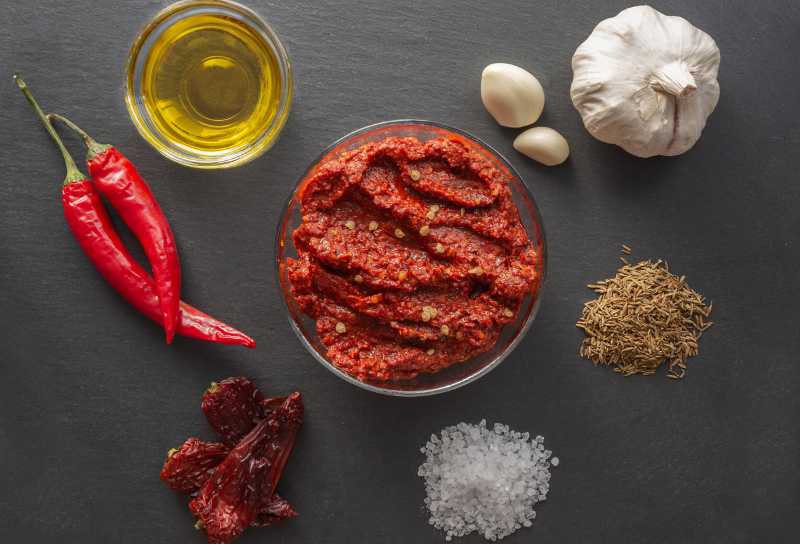
Harissa is a North African hot paste made from dried hot chili pepper, preserved lemon, spices and olive oil.
This piquant and vibrant sauce is used in combination with other spices to marinate vegetables, fish and meat and green olive or as a stand-alone dip
Ras el Hanout
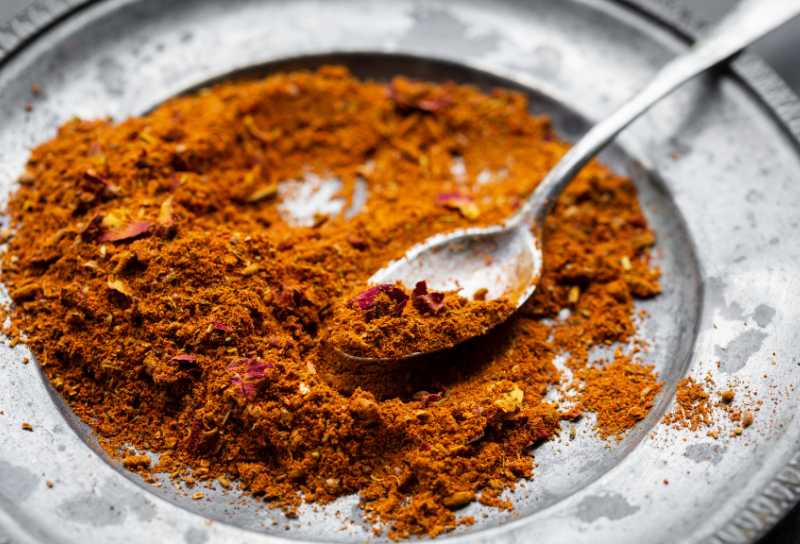
Literally translated into “head of the store”, this complex spice mix is considered a blend of the finest of what each spice store has to offer.
There exist different variations of this spice ranging from spicy to sweet.
While every version of Ras el Hanout is cut from a different cloth, they all commonly have salt, pepper, cumin, clove, turmeric, ginger, sweet and hot paprika, coriander seed, fenugreek, coriander seeds, and cardamom as a base.
The mix can extend further as it can incorporate anywhere from 10 to 100 spices including all of the spices mentioned in the article.
The sweet version also goes by the name ‘Mrozia’ in reference to the sweet and savory lamb tagine it is plentifully used in.
It is also essential in the sweet-and-savory Pastilla pie. Ras el Hanout is excellent as a rub or marinade for any type of meat or as a seasoning for tagines, vegetable stews and couscous.
Chermoula:
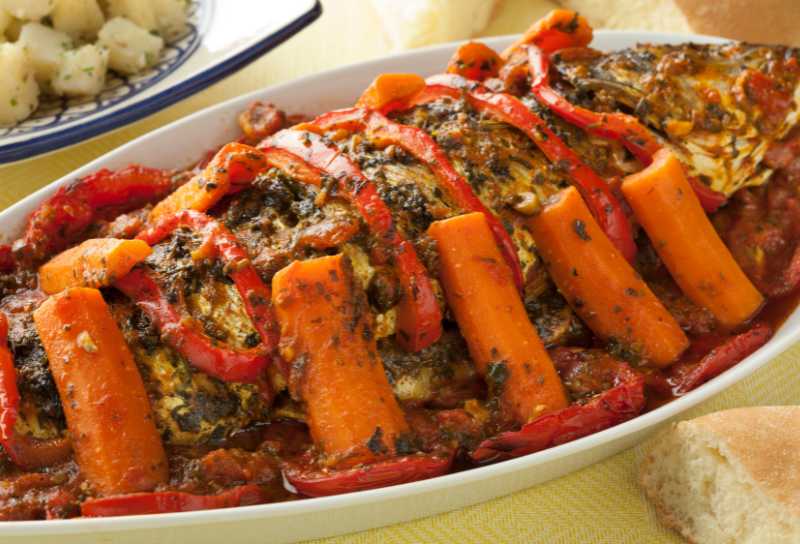
Sharmoula is a famous Moroccan homemade marinade for fish, chicken and cooked salads.
This mouth-watering, flavorsome and slightly acidic dressing is prepared with fresh herbs (parsley and coriander), spice mixes (sweet paprika, cumin, garlic), preserved lemons or vinegar as well as olive oil as a binding agent.
Like Rass El Hanout, Sharmoula also comes in different shades and tastes depending on its predet
Due to the bargaining culture of Morocco, spice prices are not fixed so negotiating the price is the way to go about it.
Although some spices might seem very pricey, they offer unbeatable value for money.
For example, the city of Tailouine in Morocco is the main source of reed gold or Saffron in Africa, hence its affordability there in comparison with other countries.
It is also the case that some other spices like cumin, cost close to nothing in Morocco making it crucial to be familiar with the prices before your next spice-shopping spree.
It has a red hue if it incorporates sweet paprika, a yellow tinge if it has turmeric and green color if it has small quantities or is void of both.
Get a Taste of Authentic Moroccan Spices!
Ready to elevate your cooking with these exquisite Moroccan spices? Explore a world of flavors and shop now
Moroccan Spices FAQs
The best place to purchase Moroccan spices and herbs, well, Morocco itself. Paying the old medina or Melah/ Jewish quarter (in Marrakech, Fes and other cities) a visit is the ideal option as many of the spices are cultivated locally and are of premium quality.
While in Morocco, the spices we recommend purchasing are the basic ones (like turmeric paprika cumin sea salt and pepper), the rare ones (like saffron) in addition to blends like Ras el Hanout blend
Due to the bargaining culture of Morocco, spice prices are not fixed so negotiating the price is the way to go about it. Although some spices might seem very pricey, they offer unbeatable value for money.
For example, the city of Tailouine in Morocco is the main source of reed gold or Saffron in Africa, hence its affordability there in comparison with other countries.
It is also the case that some other spices like cumin, cost close to nothing in Morocco making it crucial to be familiar with the prices before your next spice-shopping spree.
If Morocco is not on your travel list, no worries, the majority of Moroccan spices can still be purchased on any Moroccan, Arab, Indian or Mediterranean grocery stores.
Moroccan spices are also available online
When maintaining the spices’ freshness and potency, It is also preferable to keep them sealed away in glass jars rather than plastic bags as the latter can be porous.
As condiments are photosensitive, we also recommend placing the containers in a dark, cool and dry pantry or cabinet away from any source of heat, direct sunlight as well as moisture.
Conclusion
Spices are the essence of cooking as they can transform a seemingly simple dish into a complex and spectacular experience.
Morocco, crowned by magazines as the best international gastronomic destination is the perfect place to start to step up one’s cooking game!
The goal of this article was to introduce you to Morocco’s essential spices, their perfect dish pairings and answer some of the common questions surrounding Moroccan spice shopping
Now with this article in hand, your selection of Moroccan spices in the other and a heart full of life, unleash the artist in you and create masterpieces, not on canvas, but in the kitchen!



